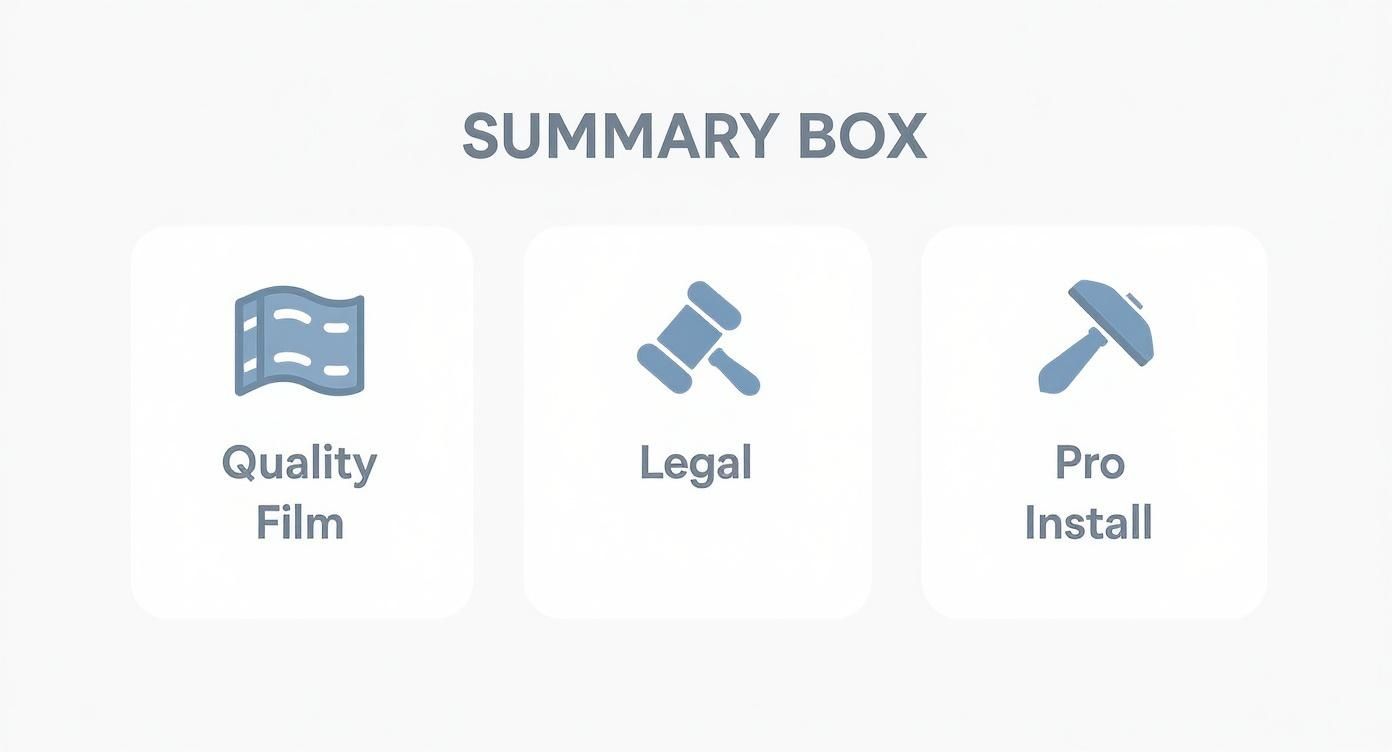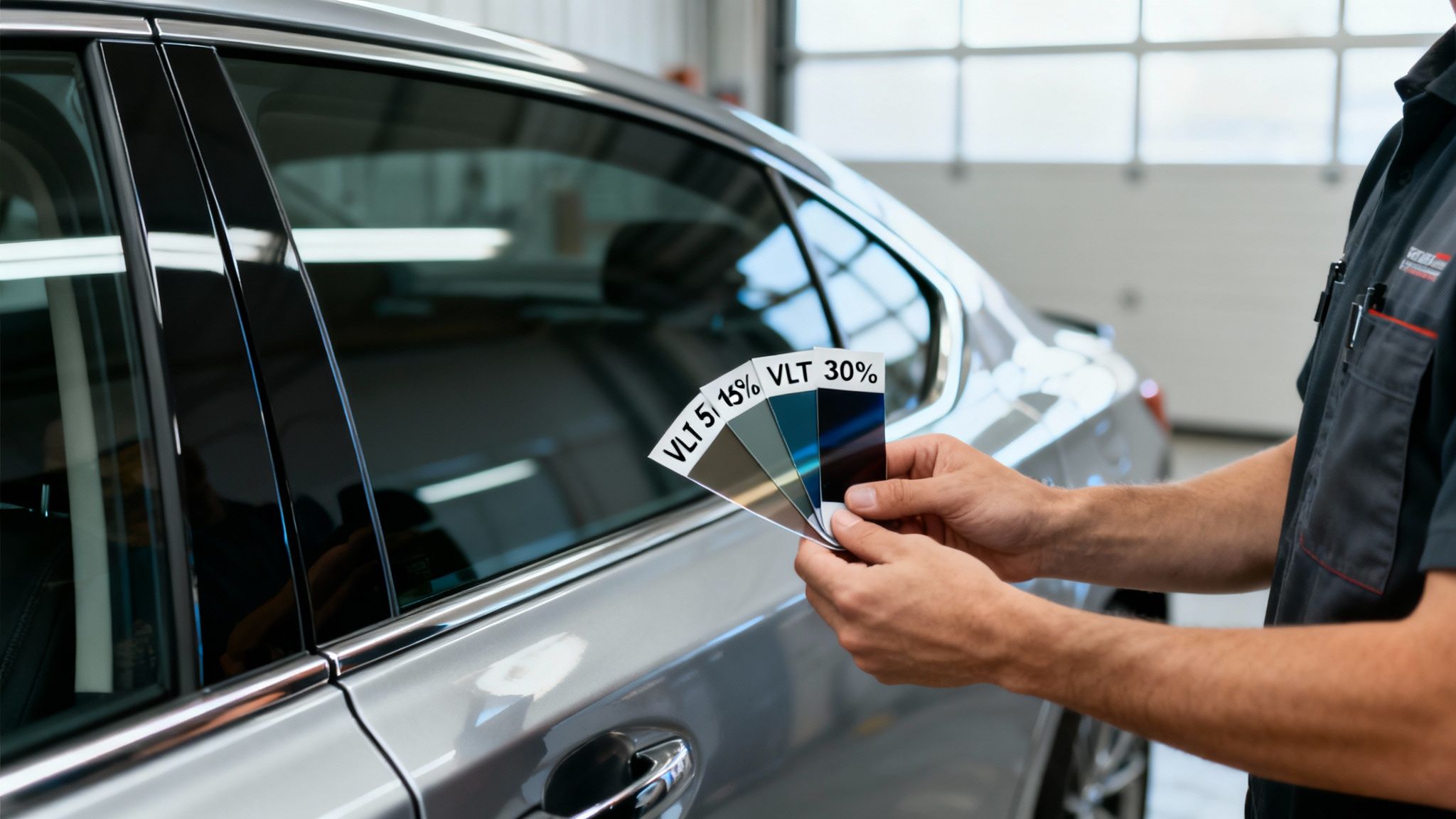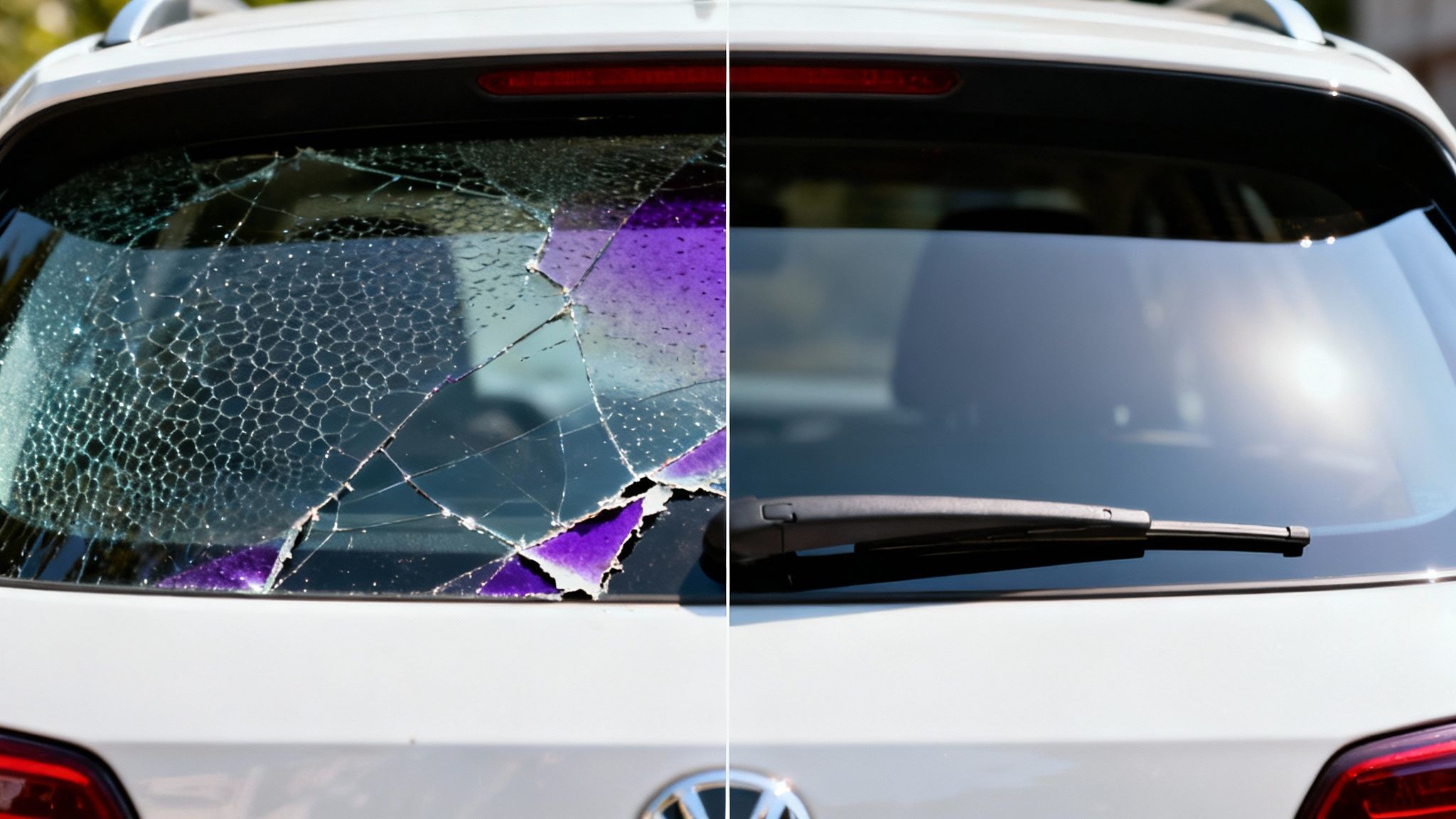When you start searching for the best auto tinting near me, you're looking for more than just a darker window. You need a shop that nails the trifecta: top-notch film, flawless installation, and a job that’s actually legal in your area. Get it right, and you'll protect your car's interior, boost your driving comfort, and give your vehicle that sharp, polished look.
Your Guide to Finding Quality Car Window Tinting
Finding a great window tinting service takes a bit more legwork than a quick Google search. Think of it as an investment in your vehicle—one that should last for years. The real trick is knowing what separates a professional job from a shoddy one that will bubble and peel in a few months.
It really comes down to a few key things: the quality of the film they use, the skill of the person applying it, and whether they understand and follow local tint laws.
This infographic breaks down the core elements you should be looking for.

Think of these as the three pillars of a fantastic tint job: high-quality materials, legal compliance, and a professional installer. If any one of these is missing, you’re setting yourself up for disappointment and probably wasting your money.
Comparing Popular Auto Tint Film Types
Let’s be honest, the film itself is the heart of any tint job. You’ll find a few different types out there, and they offer wildly different results in performance, durability, and, of course, price. Figuring out these differences is your first big step. Are you trying to beat the summer heat, get more privacy, or just want your car to look its best? Your answer will point you to the right film.
Here’s a quick breakdown of the most common options you’ll find at a professional auto shop.
Comparing Popular Auto Tint Film Types
| Film Type | Heat Rejection | UV Protection | Durability / Lifespan | Average Cost |
|---|---|---|---|---|
| Dyed Film | Low to Moderate | Excellent (99%) | 3-5 Years | $150 – $250 |
| Carbon Film | Good | Excellent (99%) | 10+ Years | $250 – $400 |
| Ceramic Film | Excellent | Excellent (99%) | Lifetime | $400 – $800+ |
As you can see from the chart, dyed film is easy on the wallet, but it doesn't do much for heat and won't last nearly as long before it starts to fade or discolour. It’s a classic case of getting what you pay for.
On the other hand, carbon and ceramic films are a bigger upfront investment, but their superior performance and incredible longevity make them a much smarter choice for most drivers. Ceramic tint, in particular, is the top of the line. It gives you the best heat rejection possible without messing with your GPS, satellite radio, or phone signal—a problem that used to plague older metallic films.
Navigating California Tint Laws

Before you even start thinking about what shade looks best, we need to talk about what’s actually legal on California roads. The state has very specific rules, and they aren't just suggestions—they’re in place to keep everyone safe. Trust me, ignoring them is a headache you don't want.
The key term you need to know is Visible Light Transmission (VLT). It’s simply the percentage of light that can pass through your window film. A lower VLT number means a darker tint. Simple as that.
In California, the rules for your front side windows are non-negotiable: they must have a VLT of 70% or higher. That means the tint has to let in at least 70% of the light, so super dark, limo-style tints are out for the driver and front passenger windows. You can dive deeper into California's 2025 tinting regulations for all the specifics, but that 70% rule is the big one.
Think about it: getting pulled over for your windows being too dark is a real pain. It usually ends with a "fix-it" ticket, which means you're on the hook to pay for the tint removal and prove to the court it's been done. That's a costly detour that’s completely avoidable from the start.
What’s Allowed On The Other Windows?
The good news? You’ve got a lot more freedom for the rest of your car. The rules relax quite a bit once you move past the front seats.
Here’s what you can do:
- Rear & Back Side Windows: Go as dark as you want. If you’re looking for maximum privacy for passengers or to keep the sun off the kids, you have free rein here.
- Windshield Strip: You’re allowed to have a non-reflective tint strip across the top 4 inches of the windshield. It’s a game-changer for cutting down on sun glare without blocking your line of sight.
- Reflective Films: Steer clear of these. Mirrored or highly reflective tints are a no-go on the front or side windows.
This is exactly why choosing the right installer is so important. When you’re looking for the best auto tinting near me, find a shop that knows these laws inside and out and guarantees their work is compliant. A true professional will help you get the look and performance you want while keeping you 100% street legal.
So, you’ve got a shortlist of local tint shops. Now comes the crucial part: figuring out who will actually do a great job and who's just talking a big game. The difference between a sleek, factory-finish tint and a bubbly, peeling mess often comes down to the details.
A suspiciously low price is usually the first red flag. Quality film and skilled labour cost money, so a rock-bottom quote often means they're cutting corners somewhere you can't see… at least, not at first.
Start your investigation online. Jump onto Google and Yelp and really dig into the reviews. Don't just glance at the star rating. Read what people are actually saying. Are there patterns? You're looking for consistent praise about flawless, clean installations. On the flip side, repeated complaints about peeling edges, trapped dust, or terrible customer service are major warning signs.
From there, check out their website's gallery and social media feeds. A shop that’s proud of its work will be eager to show it off with plenty of clear, high-quality photos.
What to Look For in Their Portfolio
When you’re scrolling through a shop’s photos, you’re not just admiring the cars—you're playing detective. You’re looking for evidence of true craftsmanship.
Pay close attention to the close-up shots. Here’s what separates the pros from the amateurs:
- Clean Edges: The film should run perfectly along the very top edge of the window, leaving no visible gap. It should look like it came from the factory that way.
- No Debris: Look for any tiny specks of dust, dirt, or hair trapped underneath the film. A professional works in an impeccably clean bay for a reason.
- Bubble-Free Finish: Small water pockets are normal right after installation and will evaporate, but big, ugly air bubbles are a sign of sloppy work.
This is the kind of meticulous work we live for. You can see what I mean by checking out our gallery of completed projects—notice the clean lines and seamless finish on every vehicle.
Here’s a pro tip: Ask if they use a computer plotter to cut the film or if they do it by hand. A computer-cutting system uses precise patterns for your exact make and model, ensuring a perfect fit every time. It also eliminates the risk of a technician accidentally scoring your glass or slicing your rubber seals with a blade.
Questions That Reveal Everything
Before you hand over your keys, get them on the phone or stop by the shop. How they answer a few key questions will tell you everything you need to know about their standards.
Don't be shy—ask them directly:
- What film brands do you use? A quality shop will proudly offer top-tier brands like XPEL or 3M. They should also be able to clearly explain the benefits of different types, like dyed, carbon, and ceramic films.
- What kind of warranty do you offer? Get the specifics. A real warranty, usually backed by the manufacturer, should cover bubbling, peeling, and colour change for life.
- How experienced are your tinters? This isn't a job for a rookie. An installer with years of experience has honed their craft on countless cars and knows how to handle every curve and tricky corner.
Finding the Right Tint Film for Your Car

The film you choose is easily the biggest factor in how well your new tint performs, how long it lasts, and what it'll cost you. Sure, you could go with a basic dyed film for privacy, but those do very little to block heat and often turn that dreaded purple colour over time. Modern film technology, on the other hand, is a complete game-changer.
A carbon film is a solid upgrade. It gives you excellent UV protection and much better heat rejection, all with a great-looking matte finish that won’t fade. But if you’re looking for the absolute best in comfort and performance, you really have to look at ceramic and nano-ceramic films. They're in a league of their own and the go-to choice for most California drivers.
Why Ceramic Is King in California
Let’s be honest, in a state famous for its sunshine, keeping your car from feeling like an oven is a huge deal. This is where ceramic tint truly shines. It’s made with non-metallic, nano-ceramic particles specifically designed to block infrared radiation, which is what actually makes your car hot.
The old metallic films used to be a problem, often messing with GPS, radio, and cell phone signals. Ceramic films are 100% signal-friendly, so you get the best heat rejection available without dropping calls or losing your navigation. It’s the perfect fit for today's connected cars.
It’s no surprise that high-quality tinting is in demand here. California drivers care about style, but also practical things like safety and comfort. Advanced films are quickly becoming the standard because they offer serious UV protection and heat rejection to deal with our intense sun. You can learn more about the latest in 2025 window tint trends on chaoppffilm.com.
Yes, the upfront cost for a premium film is higher, but think of it as an investment. You're paying for superior comfort on hot days, protection for your car's interior, and incredible longevity. High-end brands like XPEL even back their products with lifetime warranties, so you know the tint will perform for years to come. Is it worth it? If you want a noticeably cooler cabin and a tint that will never fade, bubble, or peel, then absolutely.
The Real Cost of a Bad Tint Job
We’ve all been tempted by a rock-bottom price. When you're shopping for window tint, getting a quote that’s significantly lower than the others can feel like a win. But trust me on this one: it's almost always a trap.
That initial "deal" quickly sours when you're staring at the consequences of a rushed, low-quality job. It’s not just about how it looks; it’s about the money you'll inevitably spend to fix it.
More Than Just an Eyesore
The first signs of trouble are easy to spot. You'll see those infuriating bubbles popping up, or the corners will start to peel away from the glass. These are classic hallmarks of cheap adhesive and sloppy installation. Then comes the dreaded purple haze—that’s what happens when low-grade dyes in the film break down under the sun, leaving your car looking cheap and neglected.
But the cosmetic issues are just the beginning. The real pain comes from the hidden costs. You've already paid for the bad tint job, and now you have to pay a professional again to strip that failing film off.
And be warned: removing old tint is a delicate process. It’s incredibly easy to damage the sensitive defroster lines on your rear window with a scraper. One wrong move, and that "cheap" tint job just turned into a very expensive repair.
There's also the legal side to consider. A shoddy tint job often means the film itself isn't compliant with California law. While a first-offense "fix-it" ticket might only run you $25, ignoring it can lead to fines spiraling up to $500, a suspended registration, and even problems with your insurance. You can read up on the full legal repercussions of illegal tinting on prestigelaw.com.
When it comes right down to it, putting your money into a professional installation with a solid warranty isn't an expense—it's an investment. It’s the only way to sidestep these future headaches. As you’re looking for the best "auto tinting near me," just remember that paying for quality once is always cheaper than paying to fix a mistake.
Got Questions About Window Tinting? We've Got Answers.

So, you're ready to get your windows tinted. That's great, but it's natural to have a few questions pop up before you book the appointment. Thinking about the cost, how long it'll hold up, and what to do afterward is just smart planning. Let's clear up some of the most common things people ask.
What's This Going to Cost Me?
This is usually the first question on everyone's mind, and the honest answer is: it depends. Here in California, the price tag is tied directly to the size of your vehicle and, more importantly, the quality of the film you choose.
For a smaller sedan with a basic dyed tint, you might see prices starting around $150. But if you're looking to wrap a larger SUV in a high-performance ceramic film, you should expect the cost to be closer to $500 or more. You're not just paying for a darker window; you're investing in quality, performance, and longevity.
How Long Will My Tint Actually Last?
The lifespan of your window tint comes down to one thing: the quality of the film.
Those cheap, dyed films you see advertised for a bargain might look okay at first, but they often start bubbling or fading to that dreaded purple colour within just a couple of years. On the other hand, professional-grade carbon and ceramic films are engineered for the long haul. Most reputable shops, including us, back them with a lifetime warranty because they're built to last.
Heads Up: Don't Touch That Window Switch!
A common mistake people make is rolling their windows down right after the job is done. You absolutely have to wait 3 to 5 days for the adhesive to cure properly. Rolling them down too early will cause the tint to peel right off the edges, and you'll be right back at the shop for a repair.
Is Ceramic Tint Really Worth the Extra Money?
In our professional experience, yes, it makes a world of difference. Ceramic films are the real deal. They use advanced, non-metallic nano-particles that are absolute powerhouses at blocking infrared light—that's the part of the solar spectrum you feel as heat.
This means your car's interior stays significantly cooler on those scorching hot days. Plus, unlike older metallic films, ceramic tints won't interfere with your GPS, phone signal, or radio reception. It’s a premium product with premium performance.
Ready for a flawless, long-lasting finish using the best films on the market? Trust the experts at Carmedics autowerks inc. Get your free quote today!


